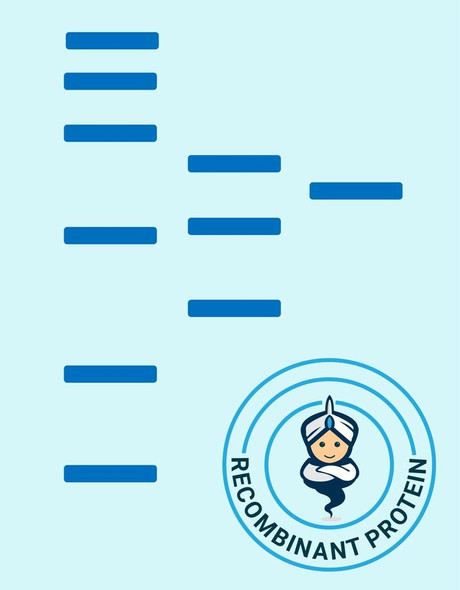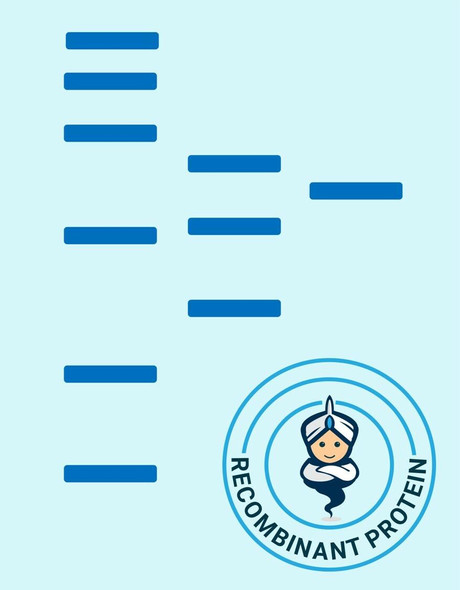Chemokines Recombinant Proteins
Human BCA-1 Recombinant Protein (RPPB1098)
- SKU:
- RPPB1098
- Product Type:
- Recombinant Protein
- Species:
- Human
- Uniprot:
- O43927
- Research Area:
- Chemokines
Description
| Product Name: | Human BCA-1 Recombinant Protein |
| Product Code: | RPPB1098 |
| Size: | 20µg |
| Species: | Human |
| Target: | BCA-1 |
| Synonyms: | C-X-C motif chemokine 13, Small-inducible cytokine B13, B lymphocyte chemoattractant, CXC chemokine BLC, CXCL13, BCA1, BCA-1, CXCL-13, B cell Attracting Chemokine-1, BLC, ANGIE, BLR1L, SCYB13, ANGIE2. |
| Source: | Escherichia Coli |
| Physical Appearance: | Sterile Filtered White lyophilized (freeze-dried) powder. |
| Formulation: | The BCA-1 protein was lyophilized from a concentrated (0.5mg/ml) solution containing 20mM PBS & 150mM NaCl pH-7.4. |
| Solubility: | It is recommended to reconstitute the lyophilized CXCL13 in sterile 18M?-cm H2O not less than 100�g/ml, which can then be further diluted to other aqueous solutions. |
| Stability: | Lyophilized BCA1 although stable at room temperature for 3 weeks, should be stored desiccated below -18°C. Upon reconstitution BCA1 should be stored at 4°C between 2-7 days and for future use below -18°C.For long term storage it is recommended to add a carrier protein (0.1% HSA or BSA).Please prevent freeze-thaw cycles. |
| Purity: | Greater than 97.0% as determined by:(a) Analysis by RP-HPLC.(b) Analysis by SDS-PAGE. |
| Amino Acid Sequence: | VLEVYYTSLRCRCVQESSVFIPRRFIDRIQILPRGNG CPRKEIIVWKKNKSIVCVDPQAEWIQRMMEVLRKR SSSTLPVPVFKRKIP |
| Biological Activity: | Determined by its ability to chemoattract human B cells using a concentration range of 1-10ng/ml corresponding to a Specific Activity of 100,000-1,000,000IU/mg. |
BCA-1 is a CXC chemokine that is highly expressed in thesecondary lymphoid organs, such as follicles of the spleen, lymph nodes, and Peyer's patches. CXCL13 promotes the migration of B lymphocytes (compared to T cells and macrophages), by stimulating calcium influx into, and chemotaxis of, cells expressing Burkitt's lymphoma receptor 1 (BLR1). BCA1 therefore function in the homing of B lymphocytes to follicles. Human BCA-1 shares a 64% amino acid sequence similarity with the mouse protein and 23 - 34% amino acid sequence identity with other known CXC chemokines. Recombinant or chemically synthesized BCA1 is a potent chemoattractant for B lymphocytes but not T lymphocytes, monocytes or neutrophils. BLR1, a G protein-coupled receptor originally isolated from Burkitt�s lymphoma cells, has now been shown to be the specific receptor for BCA1. Among cells of the hematopoietic lineages, the expression of BLR-1, now designated CXCR-5, is restricted to B lymphocytes and a subpopulation of T helper memory cells.
CXCL13 Human Recombinant produced in E.Coli is a single,non-glycosylated, polypeptide chain containing 87 amino acids and having a molecular mass of 10.3 kDa. The BCA-1 is purified by proprietary chromatographic techniques.
| UniProt Protein Function: | CXCL13: Chemotactic for B-lymphocytes but not for T-lymphocytes, monocytes and neutrophils. Does not induce calcium release in B- lymphocytes. Binds to BLR1/CXCR5. Belongs to the intercrine alpha (chemokine CxC) family. |
| UniProt Protein Details: | Protein type:Secreted, signal peptide; Motility/polarity/chemotaxis; Secreted Chromosomal Location of Human Ortholog: 4q21 Cellular Component: extracellular space; extracellular region Molecular Function:heparin binding; fibroblast growth factor binding; CXCR3 chemokine receptor binding; chemokine activity; protein heterodimerization activity; CCR10 chemokine receptor binding; CXCR5 chemokine receptor binding; receptor agonist activity Biological Process: chronic inflammatory response; lymphocyte chemotaxis across high endothelial venule; response to lipopolysaccharide; regulation of angiogenesis; positive regulation of cell-cell adhesion mediated by integrin; positive regulation of integrin activation; lymph node development; regulation of cell proliferation; G-protein coupled receptor protein signaling pathway; elevation of cytosolic calcium ion concentration; cell surface receptor linked signal transduction; cell-cell signaling; regulation of humoral immune response; defense response to bacterium; germinal center formation; immune response; inflammatory response |
| NCBI Summary: | B lymphocyte chemoattractant, independently cloned and named Angie, is an antimicrobial peptide and CXC chemokine strongly expressed in the follicles of the spleen, lymph nodes, and Peyer's patches. It preferentially promotes the migration of B lymphocytes (compared to T cells and macrophages), apparently by stimulating calcium influx into, and chemotaxis of, cells expressing Burkitt's lymphoma receptor 1 (BLR-1). It may therefore function in the homing of B lymphocytes to follicles. [provided by RefSeq, Oct 2014] |
| UniProt Code: | O43927 |
| NCBI GenInfo Identifier: | 7673945 |
| NCBI Gene ID: | 10563 |
| NCBI Accession: | O43927.1 |
| UniProt Related Accession: | O43927 |
| Molecular Weight: | 12,664 Da |
| NCBI Full Name: | C-X-C motif chemokine 13 |
| NCBI Synonym Full Names: | chemokine (C-X-C motif) ligand 13 |
| NCBI Official Symbol: | CXCL13�� |
| NCBI Official Synonym Symbols: | BLC; BCA1; ANGIE; BCA-1; BLR1L; ANGIE2; SCYB13�� |
| NCBI Protein Information: | C-X-C motif chemokine 13; CXC chemokine BLC; B-cell chemoattractant; B-lymphocyte chemoattractant; b lymphocyte chemoattractant; small-inducible cytokine B13; B-cell-attracting chemokine 1; b cell-attracting chemokine 1; chemokine (C-X-C motif) ligand 13 (B-cell chemoattractant); B-cell-homing chemokine (ligand for Burkitt's lymphoma receptor-1); small inducible cytokine B subfamily (Cys-X-Cys motif), member 13 (B-cell chemoattractant) |
| UniProt Protein Name: | C-X-C motif chemokine 13 |
| UniProt Synonym Protein Names: | Angie; B cell-attracting chemokine 1; BCA-1; B lymphocyte chemoattractant; CXC chemokine BLC; Small-inducible cytokine B13 |
| Protein Family: | Beta carbonic anhydrase |
| UniProt Gene Name: | CXCL13�� |
| UniProt Entry Name: | CXL13_HUMAN |






